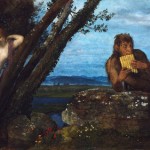For better or worse, modern Paganism and modern fandom (here’s an explanation of that term for those unfamiliar) have a lot of crossover. Whether its SCA or Ren Faire folks, genre and literary fans, or gamers, there are a ton of nerds in modern Paganism.
How exactly fandom impacts modern Pagan communities depends on the specific type of fans in an area. Here are some of my thoughts on Paganism, fandom, and how the two can intersect.
First Off, Though…
Should we be ashamed to be nerds? Should we separate our fan interests from our religion, never the twain should meet?
Eh, it depends. Some people won’t feel a need to combine their fandom and their religion. A lot of us will probably end up using some of the skills we gain by participating in fandom in our religious community, though. Whether it’s organizing and volunteering for conventions aiding in Pagan community building, or costuming skills applying to creating ritual clothing, or writing fanfic translating into writing ritual prose and poetry, there will likely be a bit of crossover.
I don’t think we need to be ashamed of being Pagans and also nerds, trying to hide away our nerdiness to give Paganism a veneer of respectability. There isn’t anything shameful about having interests and being passionate about them.
At the same time, we don’t need to give a long list of everything we’re interested in when we meet someone. Most of us learn this as we get older and socialize more often. And there is plenty within fandom to be criticized; Kaye, on their blog KALLISTI, has a post touching on why they stopped IDing as a nerd that I think nerdy Pagans should read.
Obviously I wouldn’t be writing about how to incorporate fandom with religious practice if I thought it was shameful.
Pop Culture Paganism?
I do want to note that what I’m talking about today isn’t working with or worshiping characters from fiction as if they were independent spirits or entities. Not because I’m opposed to such practices, but that isn’t really what I do.
My ‘pop culture Paganism’ is more about using modern imagery and stories to deepen my understanding of the Gods and spirits or my own devotional practice. Most of the art I have for devotional purposes is actually fanart of this or that character; I may not even be part of that specific fandom but if the image resonates…
A large reason I do this is because the Gods I worship are new. It feels uncomfortable, too tight or too loose in all the wrong areas, trying to use ancient sculptures and imagery of other Gods. I also prefer using actual God imagery for the God being depicted. Antinous might resonate to me in the same way the Dierne does, but I don’t feel comfortable using Antinous’ image for the Dierne.
And sometimes a character’s appearance just works. The tiny Otherfaith community got in a bit of a tizzy when Blue Diamond (from Steven Universe) was revealed, because… She was the Ophelia, from her height to her sorrow to her looks. That was how so many of us had experienced the Ophelia.
Figuring out where the imagery fits is one of the biggest parts of fandom-Pagan-crossover, for me.
The Lessons We Learn
A bit more insidious part of the media we consume is the lessons we take away from it. There is wiggle room for interpretation, of course, but there are also ideas being sold to us. Sometimes we’re being enticed to buy, to consume, to show off our status as fans through the accoutrements we collect. Sometimes we may be sold on an idea that we wouldn’t normally hold, but presenting it through fiction allows it to seep into us, to wiggle through our defenses.
We should be critical of the media we consume, especially when we start muddling it with our religious pursuits. This isn’t to say that we should avoid ‘problematic’ works. (I’ve found that labeling media as ‘problematic’ or – what would be the opposite? – ‘pure’ tends to result in less critical thinking on the whole, honestly.) We should figure out what a story is telling us, what resonates with us, what we like and dislike, and move forward with clearer eyes.
When Not To Combine
Another thing to be aware of with the intersection of pop culture and Paganism is the misinformation that can get spread. This is unfortunately exemplified in the amazing amount of ‘fairy lore’ that comes from table top games and modern fiction. Morgan Daimler has written and commented on this issue often.
Modern retellings of myths can also muddy our understanding of the Gods. They may inspire us to connect with a God we otherwise wouldn’t, they may introduce people to the Gods and sway them to learn about modern worship, but approaching the Gods as characters to use in a story is different than approaching Them as devotees. We shouldn’t let one author or one show determine how we perceive a deity, especially not over actual lore for the God. Even within the Otherfaith, story writing is a way to help us understand the Gods but doesn’t replace devotion, nor should one person’s story take precedence over our own experience with a God.
There are also times where we might find media to be toxic to our religious life. Maybe we feel it is offensive to the Gods and spirits. Maybe it ends up clogging our mind when we would rather focus on the Holy Ones. This is a very individual challenge, but I suspect every devotee will go through it at some point. Figuring out what needs to be cut out or changed about our lives to align better with our religious path is pretty normal.
Balance, as always, is the watchword.














